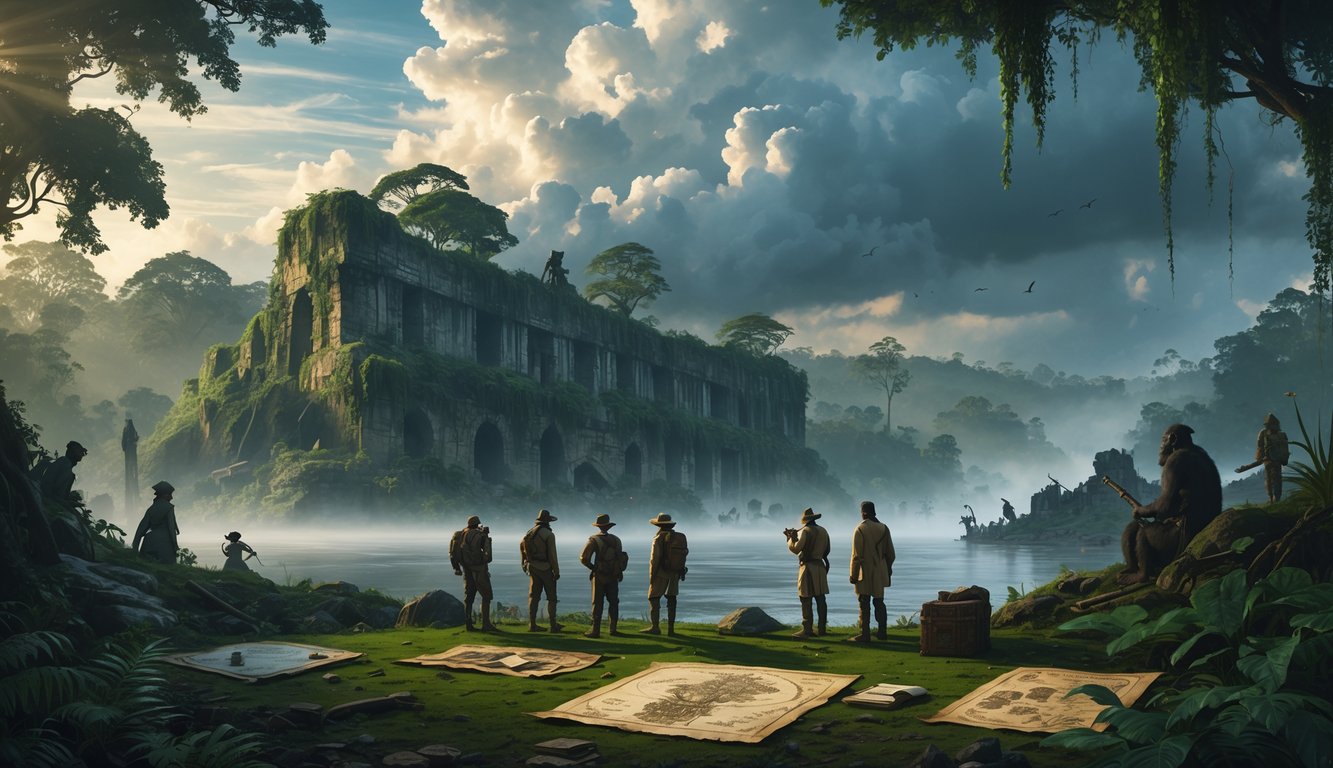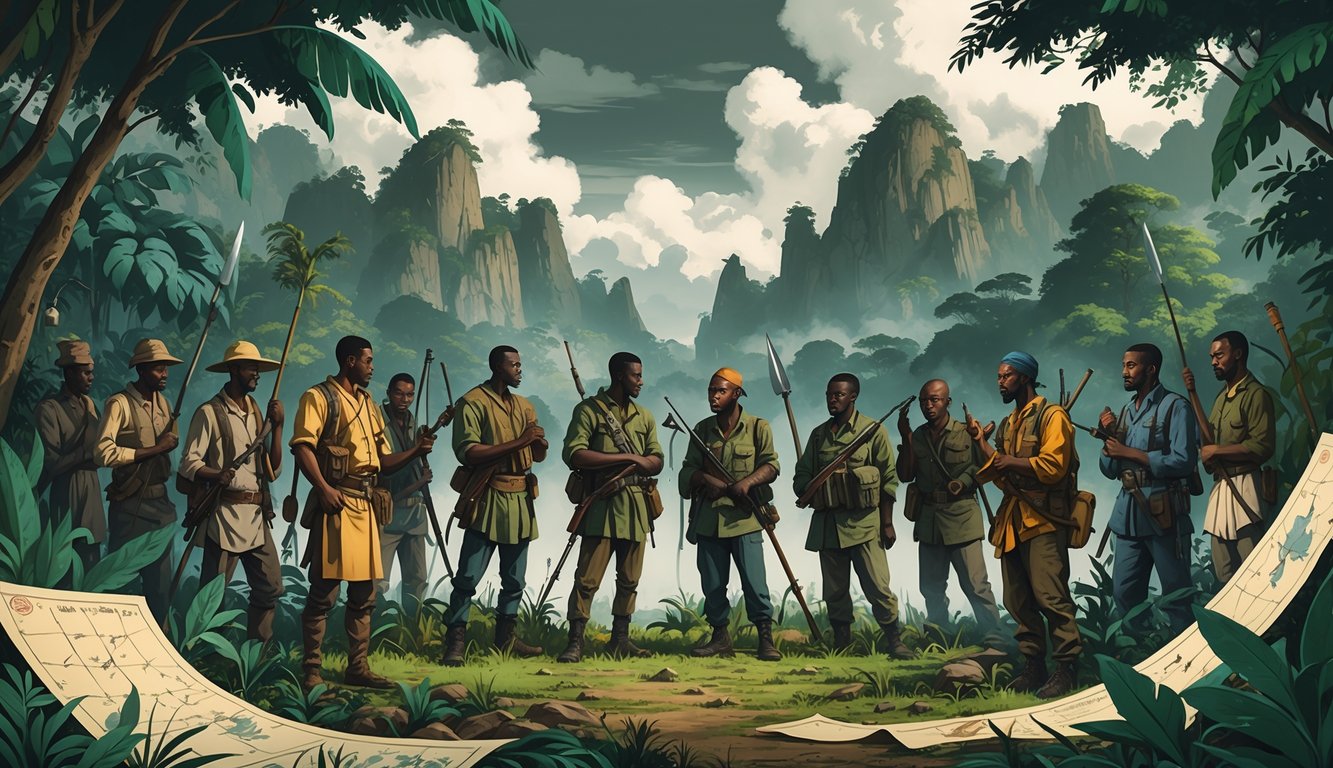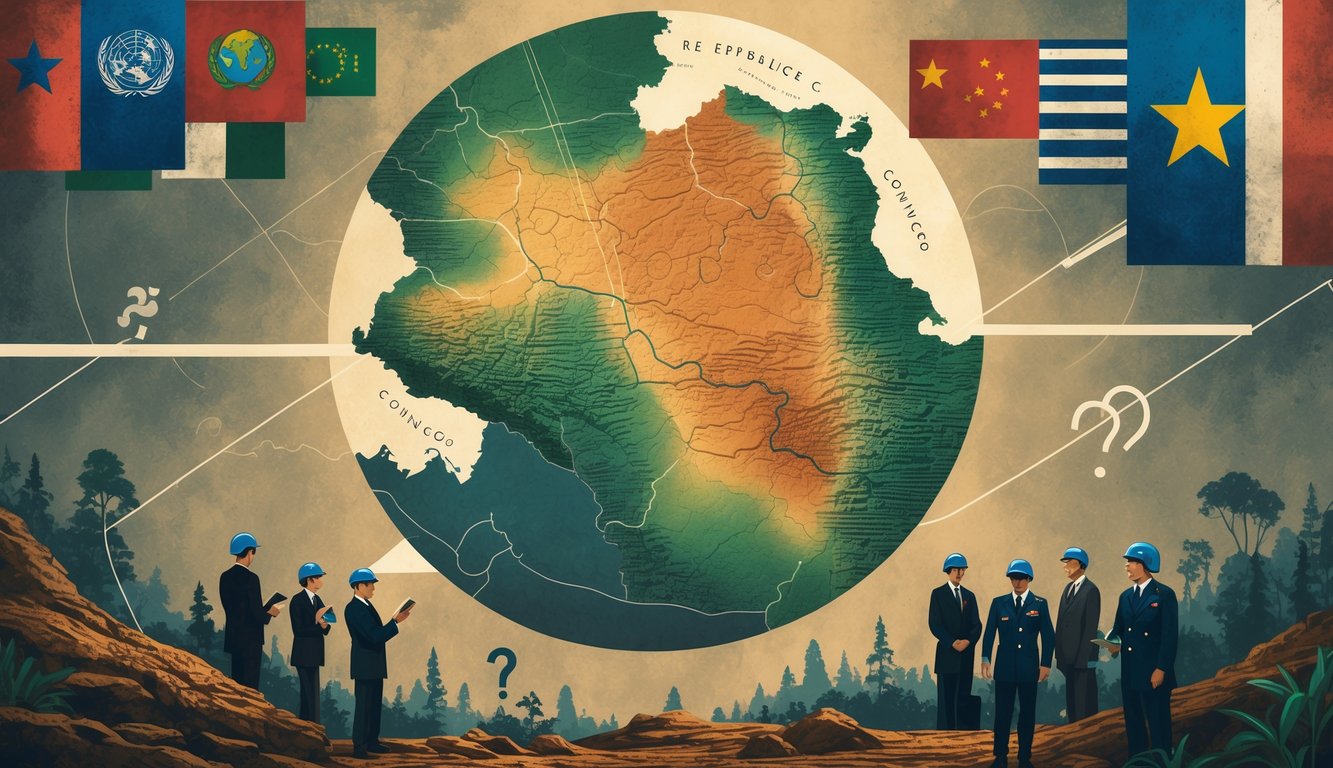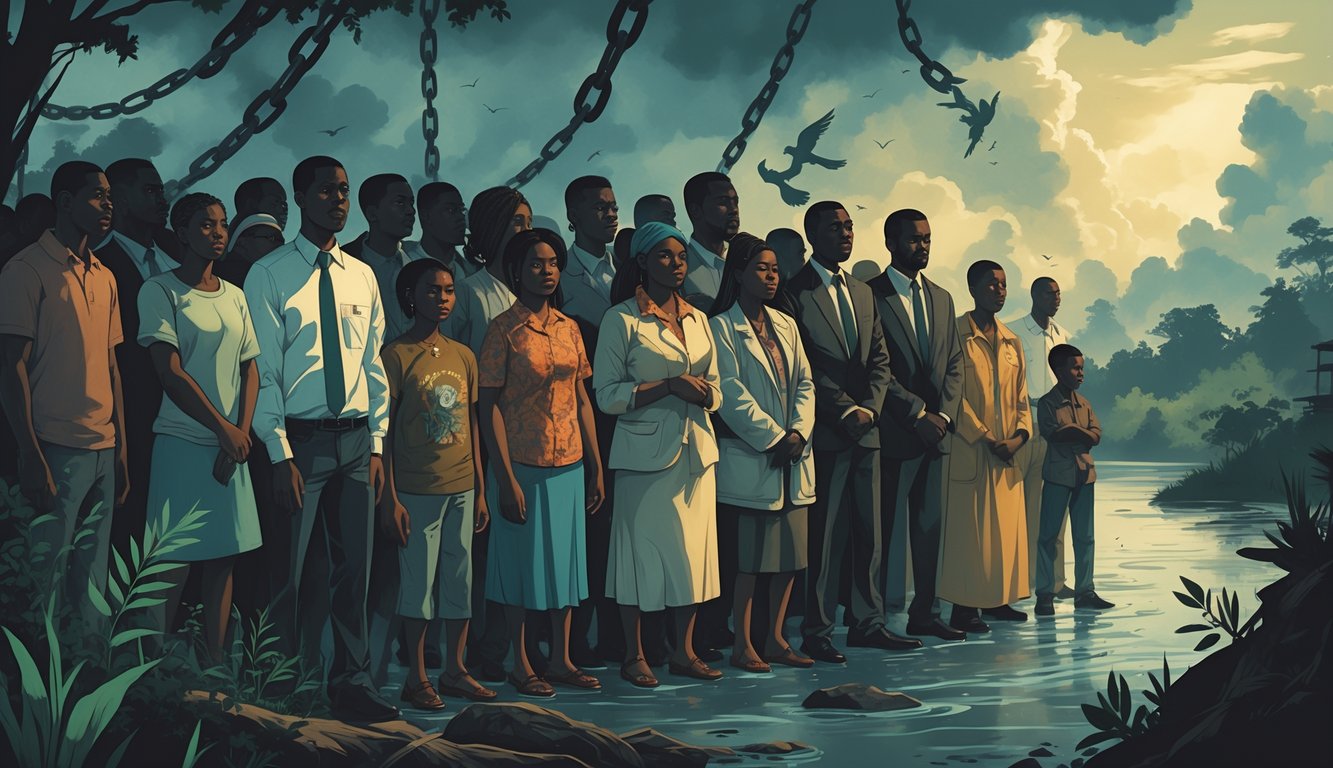The Democratic Republic of the Congo is full of secrets and strange discoveries. Deep within its rainforests and rivers, many questions remain unanswered.
Some of the biggest historical mysteries in the Congo involve hidden creatures, ancient legends, and the unexplored depths of its dense jungles.

People all over the world are amazed by stories from the Congo. Rumors of mysterious animals living in its jungles and rare findings along the Ruki River add to its mystique.
The region’s powerful past was shaped by conflict and the search for valuable minerals. Each mystery offers a glimpse into a fascinating part of Africa.
The Legacy of Colonialism and King Leopold II
Colonial rule in what is now the Democratic Republic of the Congo left a deep mark on its people and land. Forced labor, violence, and unexplained deaths changed the nation’s history.
Atrocities and Forced Labor
King Leopold II of Belgium controlled the Congo as his personal colony from 1885 to 1908. He called it the “Congo Free State.”
Under his rule, local people suffered brutal punishment if they did not meet rubber and ivory quotas. Reports describe families being held hostage and workers losing hands or lives for refusing orders or failing to collect enough resources.
Millions of Congolese died because of violence, starvation, disease, and exhaustion during this period. These abuses forced entire communities to flee or hide in the forests.
Even after Belgium took over as an official colony, forced labor for mining, agriculture, and infrastructure continued. These practices have influenced ongoing economic and social struggles in the country.
For more information, see this article about labor coercion and exploitation in the DRC.
Key facts:
- Forced labor was common in the Belgian Congo.
- Villages were destroyed for resisting colonial laws.
- Many people were killed or permanently injured.
Mysterious Deaths and Disappearances
The colonial era in the Congo saw many sudden disappearances and unexplained deaths. Some chiefs, local leaders, and resistance figures vanished after opposing colonial rule.
In many cases, families never learned what happened to them. These disappearances created a culture of fear and mistrust.
Disease and malnutrition also led to mass graves and remote deaths. Many were not recorded in any official way.
Some deaths were disguised as accidents or lost in jungle expeditions, making the real numbers hard to confirm. The trauma from these events still lingers in the memories and oral histories of many families in the Democratic Republic of the Congo.
For a deeper look at this troubled past, visit this overview of Leopold II’s legacy in the Congo.
Independence from Belgium and the Fate of Patrice Lumumba
Congo achieved independence from Belgium in 1960. The transition was marked by violence, uncertainty, and major power struggles.
Patrice Lumumba, the country’s first Prime Minister, became a symbol of hope. He also faced serious threats from inside and outside the country.
Assassination Circumstances
Patrice Lumumba led Congo to independence from Belgium in June 1960. Shortly after taking office, Lumumba’s government faced corruption, rival groups, and foreign interference.
As conflicts grew, Lumumba’s rivals arrested him and handed him to authorities in Katanga, a region seeking to break away. On January 17, 1961, Lumumba and his associates were executed in Katanga.
His body was secretly disposed of, and for decades, few details came out about what happened. The mystery around Lumumba’s death has led to ongoing calls for justice and greater transparency in the Democratic Republic of Congo.
His gold-crowned tooth was later returned and buried as part of a state funeral.
International Involvement
Many historians believe outside influence played a key part in Lumumba’s death. Belgium, the former colonial ruler, wanted to keep control over Congo’s resources.
There is strong evidence that Belgian officials helped plan and carry out the killing. The United States and other Western countries were also concerned because Lumumba was open to Soviet support during the Cold War.
United Nations peacekeepers in Congo did not stop the murder. The involvement of powerful countries in Lumumba’s fate remains a subject of debate and investigation.
Calls for justice and accountability continue in both Belgium and the Democratic Republic of Congo.
Mobutu Sese Seko’s Rule and Zaire’s Unsolved Political Mysteries
Mobutu Sese Seko led Zaire for over 30 years. He shaped nearly every part of the country’s politics.
His rule raised questions about vast corruption and missing figures who spoke out against him.
Political Corruption and Hidden Wealth
Mobutu ruled Zaire (now the Democratic Republic of the Congo) with an “iron fist.” He created a system where power stayed close to him and trusted friends.
Most of the country’s wealth, especially from minerals, went to a small group at the top. During Mobutu’s time, billions of dollars disappeared from the state budget.
Reports and investigations said Mobutu kept large amounts of money in foreign bank accounts. These secret funds became one of Africa’s most whispered-about mysteries.
After Mobutu left power, no one found the full extent of his fortune. Other leaders from his government also took part in large-scale corruption.
The people of Zaire faced poverty while Mobutu and his allies lived in luxury. Questions remain about where much of this stolen money went.
No official list of all his foreign assets has ever been shared with the public.
| Key Fact | Details |
|---|---|
| Ruler | Mobutu Sese Seko |
| Era | 1965 to 1997 |
| Known for | Corruption, lost state funds, hidden wealth |
Disappearances of Opposition Leaders
One of the darkest parts of Mobutu’s rule was the fate of opposition leaders. Many politicians, activists, and journalists who stood against him vanished without a trace.
Some were jailed with no trial. Others were never seen again.
Families of missing individuals received no answers from the government. Reports of secret prisons and extrajudicial actions surfaced during Mobutu’s years in power.
Most of these cases remain unsolved, and the truth behind these disappearances is still unknown. This climate of fear helped Mobutu keep control and forced people to stay quiet.
Many who lost family members are still waiting for information. The legacy of these events still affects how the DRC faces political dissent.
The Congo Wars and Unresolved Conflicts
The Democratic Republic of the Congo has faced years of violence. Two major wars marked the late 20th century.
These conflicts have left many questions about the causes and long-term effects.
Origins of the First Congo War
The First Congo War began in 1996. Laurent Kabila and the Alliance of Democratic Forces for the Liberation of Congo-Zaire (AFDL) started a rebellion to overthrow Mobutu Sese Seko.
Neighboring countries like Rwanda and Uganda supported Kabila’s force. They wanted to remove Mobutu, who was accused of helping Rwandan Hutu rebels linked to the 1994 genocide.
The war quickly spread across Congo, pulling in many groups with their own goals. Resources like diamonds and minerals played a big part in the fighting.
Mobutu’s government fell in 1997, and Kabila became president. The power shift did not solve the deep problems in the country.
Tensions, armed groups, and confusion over resources and borders made peace hard to reach. For more on this part of Congo’s history, visit this case study on the First Congo War.
Outbreak of the Second Congo War
The Second Congo War started in 1998, just one year after the first. New tensions grew between President Laurent Kabila and the countries that helped him rise to power.
Many African nations became involved, earning the war the nickname Africa’s World War. Armies from Rwanda, Uganda, Zimbabwe, Angola, Namibia, and others joined the conflict.
Local militias also took sides, making the fighting even more confusing. Millions of people were affected.
Violence, hunger, and disease led to a major humanitarian crisis. Even after a peace deal in 2003, armed conflict and unrest continued.
The eastern Congo remains especially troubled. The aftershocks of this war remain a big challenge, as shown in this detailed list of conflicts involving the DRC.
Roles of Armed Groups, Militias, and Rebel Movements

Armed groups and militias have played a huge part in the Democratic Republic of the Congo’s (DRC) history. The activities of the Congolese army, rebel organizations, and ethnic militias have shaped politics and everyday life in many regions.
Rise of the Congolese Army and Rebel Groups
The Congolese army, also called FARDC, developed after years of conflict and political changes. Over time, many rebel groups formed because of weak central control, disputes over resources, and local power struggles.
These militias and armed groups often fought the army and each other. This led to ongoing insecurity in many parts of the country.
Some rebel groups gained support from frustrated citizens who felt ignored by the main government. Others acted mainly to control mines or trade routes, making violence about more than just politics.
The government and the army have struggled to maintain order, especially in provinces far from the capital. Groups such as the Mai-Mai and other militias have controlled entire towns or rural areas.
Their presence is still felt today. Their actions have a big impact on people’s safety, the economy, and hopes for peace.
For a deeper look at how armed groups shape the conflict, see the overview of Congo’s conflict.
Influence of M23 and Banyamulenge
One of the most talked-about rebel groups in recent years is M23. M23 is made up mostly of ethnic Tutsis who broke away from the Congolese army about a decade ago.
In 2012, M23 fighters captured the large city of Goma. This event showed how powerful they could be.
The Banyamulenge, an ethnic group found in eastern Congo, have also formed their own militias. These groups say they need to protect their communities from attacks by other armed groups.
Conflict involving the Banyamulenge and M23 has led to accusations of ethnic violence. Many local people have been displaced.
M23’s return to fighting in recent years has caused major problems in eastern Congo. The struggles tied to these groups highlight the complex mix of ethnicity, politics, and armed power that shape life in the region.
Ethnic Tensions, Violence, and Genocides
Ethnic violence in the Democratic Republic of the Congo (DRC) connects deeply to conflicts in nearby countries. These struggles often link back to Rwanda and Burundi.
They have played a major role in sparking violence, displacement, and humanitarian crises.
Rwandan and Burundian Involvement
After the 1994 Rwandan genocide, about two million refugees—mainly Hutu—fled into what is now the DRC. Many of these refugees feared retaliation after the genocide in Rwanda.
Their arrival added stress to the country’s already fragile ethnic balance. Armed groups from Rwanda and Burundi, including ex-soldiers and militia, entered the DRC and formed alliances with local forces.
The presence of foreign fighters drew Rwanda and Burundi into the DRC’s conflicts. Governments from these countries often justified crossing the border as a way to target fighters hiding in Congolese territory.
Battles between these armed groups have led to widespread displacement and suffering for many communities. Power struggles, natural resource competition, and old rivalries continue to fuel violence.
These issues have turned eastern DRC into a site of repeated violence that is hard to control. For more, see this guide to the decades-long conflict in DR Congo.
Hutu and Tutsi Conflicts
The rivalry between Hutu and Tutsi ethnic groups has caused deep wounds in the Great Lakes region. The genocide in Rwanda, led by Hutu extremists against Tutsis, resulted in the killings of around 800,000 people, mostly Tutsi.
Spillover from this event brought violence and mistrust into the DRC. Once in Congolese territory, many Hutu and Tutsi formed their own armed groups.
Clashes between these groups, along with attacks on civilians, have added to the chaos. The violence is not only about the past—it continues to affect new generations in the region.
The arrival of so many Hutu refugees, along with fears of revenge by Tutsi-led forces, increased the chance of violent confrontations in the DRC. Ethnic tensions make peace talks harder and remain a major reason for ongoing instability, as noted in this review of post-colonial conflict.
Key ethnic groups involved:
- Hutu
- Tutsi
- Local Congolese communities
Hidden Wealth: Natural Resources and International Interests
The Democratic Republic of the Congo (DRC) has some of the world’s richest natural resources. Yet, many people in the DRC still live in poverty while billions of dollars in minerals leave the country each year.
Resource Exploitation and Smuggling
The DRC holds huge deposits of cobalt, copper, diamonds, gold, and coltan. Some estimate its unexploited minerals are worth about 24 trillion US dollars.
However, these riches have not benefited most Congolese people. International companies and smugglers work with local groups to extract minerals.
Smuggling is common, especially in eastern areas like North Kivu, South Kivu, and Katanga. Armed groups often control the mines and border crossings.
They use violence to keep control of the mining sites and smuggling routes. Corruption is a major problem.
Some officials get paid to ignore illegal shipments. The justice system faces threats and bribes that make it hard to punish those responsible.
In many cases, only a small group profits while the majority faces hardship.
Key facts:
- Main regions: North Kivu, South Kivu, Katanga
- Problems: Smuggling, corruption, violence
- Result: Wealth leaves the DRC, ordinary people see little benefit
Mysterious Disappearances Around Mining
People who investigate illegal mining or stand up against powerful interests in the DRC often go missing. Human rights workers, journalists, and local leaders have all disappeared under suspicious circumstances.
Many of these cases link to mining zones controlled by militias or foreign actors. Some disappearances happen in places where valuable minerals are extracted or transported.
Areas like North Kivu are the most dangerous. There is rarely justice for the families.
Witnesses may be afraid to speak, and police investigations often do not move forward. The cases show how risky it is to challenge those involved in illegal mining and resource trafficking.
Impact of Foreign Countries and the United Nations

Foreign countries and the United Nations have shaped the Democratic Republic of the Congo’s history in unique ways. Outside powers influenced major conflicts, humanitarian actions, and peacekeeping efforts—sometimes with hidden agendas or results that remain debated even today.
Rwandan, Ugandan, and Other Regional Influences
After the 1994 Rwandan Genocide, millions of people fled to neighboring countries. Armed groups and former fighters entered Eastern Congo, causing violence to grow across Central Africa.
The Rwandan government and Uganda sent troops into Congo, saying they wanted to protect their borders and stop rebels. Local communities faced loss of land and homes.
Fighting between armed groups and government forces displaced many people. Children lost regular access to education.
Countries like Kenya and Tanzania joined peace talks. They hoped to support dialogue and find a path to a ceasefire.
Key Impacts:
- Regional armies took valuable resources, including gold and diamonds.
- New rebel groups formed, changing power in the region.
- Large numbers of displaced persons still live in camps or with relatives.
Lingering questions include the full scale of foreign involvement and the reasons behind support for specific rebel groups. For more background, read a detailed conflict history.
United Nations’ Peacekeeping Mysteries
The United Nations has had one of its largest peacekeeping missions ever in Congo, called MONUSCO. Soldiers and experts from different countries have tried to protect civilians, help open schools, and offer medical aid.
Many question whether the UN achieved its goals. Some people say the missions did not always stop violence or prevent mass displacements.
Others point out that United Nations’ negotiations sometimes failed to create a lasting ceasefire among fighting groups. The UN also worked with Congolese leaders to support more education and protect displaced people, but ongoing conflicts made their work harder.
Important details:
- MONUSCO involved contributions from nations like Kenya and Tanzania.
- Several peace agreements did not hold for long.
- Many families still wait for full peace and the chance to rebuild.
There are still mysteries about internal UN decisions, hidden motives, and why certain regions received more protection than others. A closer look at a United Nations case study offers more on the peacekeeping challenges.
The Congo Rainforest and Mysterious Discoveries
The Congo Rainforest covers millions of acres across Central Africa. It is home to thousands of animal and plant species.
Its remote landscape holds many secrets, from lost cultures to unexplained events that puzzle researchers.
Exploration Challenges and Lost Civilizations
Dense forests and tangled rivers make the Congo Rainforest hard to explore. Scientists and explorers face many obstacles, such as dangerous wildlife, thick undergrowth, and unpredictable weather.
Clues suggest that ancient civilizations once lived here. Some researchers have found ruins and artifacts that raise new questions, like who built them or why the sites were left behind.
The forest’s size means many areas have never been fully mapped. Legends talk about lost cities and tribes deep in the jungle, adding to the air of mystery.
Mysterious ruins and unexplored places may still hide more history under the trees.
Strange Phenomena and Scientific Mysteries
The Congo Rainforest is also known for strange events and rare creatures. Scientists have discovered odd animals and plants that aren’t found anywhere else.
Some believe more are waiting to be found. Strange lights, odd animal sightings, and unusual weather are sometimes reported by locals.
Scientists have studied unique features such as the Ruki River, which was only recently explored by researchers. Many weird discoveries in the thick rainforest still challenge scientific explanation and fuel more research.
Ongoing Human Rights Violations and Justice Efforts

Human rights violations have impacted many people in the Democratic Republic of the Congo for years. Civilians face violence, abuse, and a lack of access to fair justice and proper healthcare.
Unsolved Cases of Torture and Abuse
Reports from human rights groups reveal that torture and abuse continue to be major issues across the country. Armed conflicts in the eastern provinces have led to repeated attacks against civilians, including forced disappearances, extrajudicial killings, and physical torture.
Various armed groups and some government forces have been accused of these abuses. A large number of these cases remain unsolved.
Investigations are often slow or nonexistent, leaving victims with little hope for justice or healing. The lack of proper response from authorities has contributed to a cycle of violence.
This failure has also made it hard for survivors to get safe access to medical care and support for trauma. Many communities still fear further violence as a result of unresolved abuses.
You can read more about these ongoing violations at Human Rights Watch and the U.S. Department of State.
Barriers to Achieving Justice
Several challenges block justice for victims of human rights abuses. The justice system in the Democratic Republic of the Congo faces a lack of resources and limited independence.
Corruption affects the courts and police. Police and courts often do not investigate or prosecute powerful suspects, including members of the armed forces and the Force Publique.
Ongoing violence from civil wars disrupts legal processes. This violence also threatens the safety of witnesses, lawyers, and judges.
Victims are often too afraid to report crimes. Many lack access to basic legal aid and do not trust the courts to protect their rights.
For more about the challenges to justice in Congo, visit Conflict in the Democratic Republic of Congo and the UN’s warning about threats to defenders.




